

 Despite of valiant effort by numerous local and international organizations, so far there was not much being done in the post-Yugoslav societies on conflict resolution among the gender/age group most likely to perpetrate atrocities, as if young males do not respond to the traditional conflict resolution approaches well.
Despite of valiant effort by numerous local and international organizations, so far there was not much being done in the post-Yugoslav societies on conflict resolution among the gender/age group most likely to perpetrate atrocities, as if young males do not respond to the traditional conflict resolution approaches well.
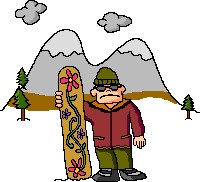 Post-Communist Central and Eastern Europe experienced high levels of ethnic violence in the transition-to-democracy period. That violence was at its highest peaks in the South-East region, once known as Socialist Federative Republic of Yugoslavia. This project would pick up willing minority youth, traumatized and/or victimized by that ethnic violence, from all parts of Central and Eastern Europe (in the first stages the project may concentrate on former Yugoslavia, or more precisely on Bosnia) and bring them together in the "extreme" peace camp. There they would learn a new skill (that they consider ‘fun’) and they would learn to trust themselves and their new friends, while unlearning to trust the forces outside their control, like the irrational forces of ethnic cohesion to which many of them had surrendered. By focusing on the new skill that they all want to learn, they would set aside the potential grievances against other camp participants, and, as they all together become more proficient at their new skills, they might also be willing to look together at those grievances in the different light.
Post-Communist Central and Eastern Europe experienced high levels of ethnic violence in the transition-to-democracy period. That violence was at its highest peaks in the South-East region, once known as Socialist Federative Republic of Yugoslavia. This project would pick up willing minority youth, traumatized and/or victimized by that ethnic violence, from all parts of Central and Eastern Europe (in the first stages the project may concentrate on former Yugoslavia, or more precisely on Bosnia) and bring them together in the "extreme" peace camp. There they would learn a new skill (that they consider ‘fun’) and they would learn to trust themselves and their new friends, while unlearning to trust the forces outside their control, like the irrational forces of ethnic cohesion to which many of them had surrendered. By focusing on the new skill that they all want to learn, they would set aside the potential grievances against other camp participants, and, as they all together become more proficient at their new skills, they might also be willing to look together at those grievances in the different light.
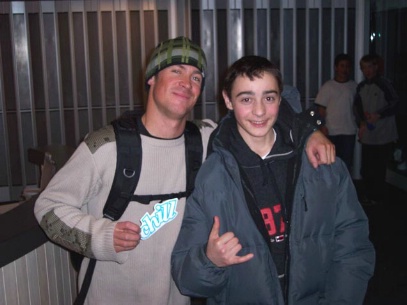 During winter 2004 one of the participants of the Chill program at Bolton Valley, Vermont was Emir Sadikovic, a 14 years old Bosnian refugee from Tesanj, near Sarajevo. This is him in picture with New Zealand half-pipe champion Dylan Butt, who visited Chill program at Bolton Valley in February. Click on picture for the story. Click here to see Emir ride, and to hear his story: how did Chill program change his life, and how would the similar program change lives of many kids like him in the territories of former Yugoslavia.
During winter 2004 one of the participants of the Chill program at Bolton Valley, Vermont was Emir Sadikovic, a 14 years old Bosnian refugee from Tesanj, near Sarajevo. This is him in picture with New Zealand half-pipe champion Dylan Butt, who visited Chill program at Bolton Valley in February. Click on picture for the story. Click here to see Emir ride, and to hear his story: how did Chill program change his life, and how would the similar program change lives of many kids like him in the territories of former Yugoslavia.
 So, here I am, crossing the invisible, yet very palpable inter-entity border, entering the city of Serbian Sarajevo, a string of widely spaced houses in a wild canyon of river Miljacka, on a road that experienced a severe landslide recently, and now it is open only a few hours every day. The roads on the Serbian side are even worse than they are on the Federation side. And the antiquated, weathered road signs do not seem to point anywhere in particular. We just passed the land-mine awareness poster. It is a sunny March morning, and there is no lift accessible snow on Bjelasnica, in the Bosnian-Croat Federation. The lift service to the top, destroyed during three year siege of Sarajevo, was obviously not a priority to the feuding, foreign aid expecting, aging Olympic Committee that manages the mountain since 1984. There is no snow-making either, since the snow-guns were shipped to Slovenia immediately after the games were over:
So, here I am, crossing the invisible, yet very palpable inter-entity border, entering the city of Serbian Sarajevo, a string of widely spaced houses in a wild canyon of river Miljacka, on a road that experienced a severe landslide recently, and now it is open only a few hours every day. The roads on the Serbian side are even worse than they are on the Federation side. And the antiquated, weathered road signs do not seem to point anywhere in particular. We just passed the land-mine awareness poster. It is a sunny March morning, and there is no lift accessible snow on Bjelasnica, in the Bosnian-Croat Federation. The lift service to the top, destroyed during three year siege of Sarajevo, was obviously not a priority to the feuding, foreign aid expecting, aging Olympic Committee that manages the mountain since 1984. There is no snow-making either, since the snow-guns were shipped to Slovenia immediately after the games were over: 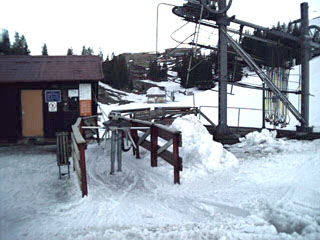 the old Yugoslav rationale was that Slovenia with developed snow-sport tourist economy would put those guns to a better use than Bosnians, who do have mean mountains, but no mountaineering tradition and related tourist industry. In the matter of fact - there is nothing on Bjelasnica, except for two lifts that do not reach snowcover today: the war took a heavy toll there. And nobody among the Sarajevo riders was eager to take me for a hike. Therefore, we simply had to go to Jahorina, to Republika Srpska. There is no snow making on Jahorina, either, and the lifts are in disrepair, and the roads are barely drivable, but at least we can get to the top of a snow covered slope. As soon as we arrived, there was a power black-out, so the lift stopped running.
the old Yugoslav rationale was that Slovenia with developed snow-sport tourist economy would put those guns to a better use than Bosnians, who do have mean mountains, but no mountaineering tradition and related tourist industry. In the matter of fact - there is nothing on Bjelasnica, except for two lifts that do not reach snowcover today: the war took a heavy toll there. And nobody among the Sarajevo riders was eager to take me for a hike. Therefore, we simply had to go to Jahorina, to Republika Srpska. There is no snow making on Jahorina, either, and the lifts are in disrepair, and the roads are barely drivable, but at least we can get to the top of a snow covered slope. As soon as we arrived, there was a power black-out, so the lift stopped running.
The only operating hotel there, Hotel Bistrica, formerly the headquarters of Radovan Karadzic and his war-criminal government, is in the good shape. For less than four dollars each, Craig and me had a hefty, pork fat laden, breakfast Serbian style, and started inquiring about the snowboard school. Hotel employees would usually run away from us, as soon as they would hear my accent, or realize that Craig is an American. So, we left in search of company that harbors less prejudice. At the café Brazil there was a sign advertising a ski and snowboard school. I went in.  They told me that the snowboard instruction at Jahorina boils down to one man, some individual named Miljan (Boskovic), who operates out of a newly built bed and breakfast, aptly named Luda Kuca (The Mad House). We went there. Built all from wood, kind of off road, tucked in the forest, with the morning Northwestern-like waist-high fog still lingering among the tall pines, it looked like the place where elves would live in some Disney production. As I entered in, and saw young people hanging in there, I instinctively knew I was at the right place.
They told me that the snowboard instruction at Jahorina boils down to one man, some individual named Miljan (Boskovic), who operates out of a newly built bed and breakfast, aptly named Luda Kuca (The Mad House). We went there. Built all from wood, kind of off road, tucked in the forest, with the morning Northwestern-like waist-high fog still lingering among the tall pines, it looked like the place where elves would live in some Disney production. As I entered in, and saw young people hanging in there, I instinctively knew I was at the right place.
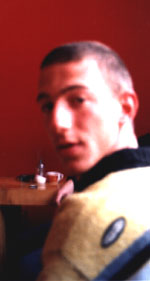 And there could be no mistake who Miljan was. Lean, lanky youth with very short haircut and tanned face, except for the portion usually covered with goggles, humble in demeanor and full of joy, itching to jump and spin.
And there could be no mistake who Miljan was. Lean, lanky youth with very short haircut and tanned face, except for the portion usually covered with goggles, humble in demeanor and full of joy, itching to jump and spin. 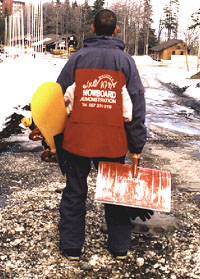 He was already all packed up, because they were all ready to leave. It was their last day, the end of season - they were going back to Belgrade, where they are all from: Luda Kuca is owned and operated by young crowd from Belgrade, that understands how much evil did the local Serbs both commit and suffer in the past decade, but kind of would like to open their eyes more to the future and have some fun and joy in life, instead of dwelling in the common miserable past. And they are dirt-cheap - bed and two meals daily go for less than $10. After a little arm-twisting I had Miljan re-assemble his snowboard - this season’s Burton Seven with Burton CFX bindings (Burton rep for Serbia, Vesna Jeremica, cut him a good deal, he says)
He was already all packed up, because they were all ready to leave. It was their last day, the end of season - they were going back to Belgrade, where they are all from: Luda Kuca is owned and operated by young crowd from Belgrade, that understands how much evil did the local Serbs both commit and suffer in the past decade, but kind of would like to open their eyes more to the future and have some fun and joy in life, instead of dwelling in the common miserable past. And they are dirt-cheap - bed and two meals daily go for less than $10. After a little arm-twisting I had Miljan re-assemble his snowboard - this season’s Burton Seven with Burton CFX bindings (Burton rep for Serbia, Vesna Jeremica, cut him a good deal, he says)  - and put his boots on. In an hour we were hiking the slope, our boards under one arm, shovels under another, ready to build a jump. As we finished the 5 feet tall kicker, three kids hiked up to us holding PVC bags (the kind you get in the supermarket to pack your groceries in) in thie arms. They came to watch, smiling broadly, no prejudice there. The PVC bags, I learned then, were their sleighs. They used them quite well.
- and put his boots on. In an hour we were hiking the slope, our boards under one arm, shovels under another, ready to build a jump. As we finished the 5 feet tall kicker, three kids hiked up to us holding PVC bags (the kind you get in the supermarket to pack your groceries in) in thie arms. They came to watch, smiling broadly, no prejudice there. The PVC bags, I learned then, were their sleighs. They used them quite well.
 As the riders on the Federation side rightfully complain that Serbs destroyed their slopes and lifts, so they essentially have to go to Slovenia to ride, the Serbian riders generally, because Serbia was isolated under sanctions for the past decade, did not ride outside their borders. Miljan Boskovic never rode anywhere else but Kopaonik, Brezovica and Jahorina.
As the riders on the Federation side rightfully complain that Serbs destroyed their slopes and lifts, so they essentially have to go to Slovenia to ride, the Serbian riders generally, because Serbia was isolated under sanctions for the past decade, did not ride outside their borders. Miljan Boskovic never rode anywhere else but Kopaonik, Brezovica and Jahorina.  He learned his tricks watching U.S. videos. He learned it well: mute, method grabs, 540-s, trademark front flips, supermans... And that despite of mountain operations being as friendly to snowboarders on the both side of the inter-entity border, as they were in the US in the early eighties. There is no park or pipe on either Bjelasnica or Jahorina.
He learned his tricks watching U.S. videos. He learned it well: mute, method grabs, 540-s, trademark front flips, supermans... And that despite of mountain operations being as friendly to snowboarders on the both side of the inter-entity border, as they were in the US in the early eighties. There is no park or pipe on either Bjelasnica or Jahorina.  A one time big air and boarder-cross events were OK-ed on Bjelasnica last winter, when there was plenty of snow, and placed on hard to reach unused trails. The jumps and kickers that riders build themselves are destroyed by cats first thing before grooming any trails - on both sides. More outrageously, Sarajevo cantonal government gave free lift passes to ski clubs but not to snowboard clubs.
A one time big air and boarder-cross events were OK-ed on Bjelasnica last winter, when there was plenty of snow, and placed on hard to reach unused trails. The jumps and kickers that riders build themselves are destroyed by cats first thing before grooming any trails - on both sides. More outrageously, Sarajevo cantonal government gave free lift passes to ski clubs but not to snowboard clubs.
The only lift on Jahorina that opened later that day, a 17 years old poma lift, was clearly marked with a sign "Banned for ski-boards" 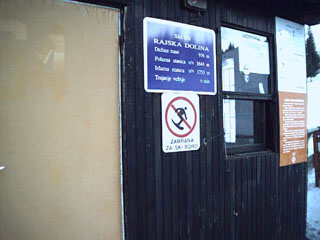 - that’s how locals call snowboards; ski-boards they didn’t see yet, obviously. Usually, a bottle of hard liquor (loza) to the lift operator would open the access to the lift by a willing snowboarder (but it is indeed a very, very steep and hard lift to handle for inexperienced riders). They knew Miljan, though: he is kind of a local circus attraction - well nobody in the about one thousand riders strong Serbia or Bosnia except for him can do a 540 rodeo, that’s for sure (Jurica Stankovic from Kopaonik, another Burton helped rider in Serbia, and the GS champion of Yugoslavia is more of a free-rider: for more info on snowboarding in Yugoslavia click here) - so they let us two on the lift. Lifts have turn-styles at the entry, like the New York subway, you have to punch your ticket to pass through (daily lift pass is less than $10), but just like the New York subway, some of those turn-styles can be cheated, like the left turn-style on this particular lift: Miljan promptly shared that important knowledge with a fellow rider. Thanks, dude.
- that’s how locals call snowboards; ski-boards they didn’t see yet, obviously. Usually, a bottle of hard liquor (loza) to the lift operator would open the access to the lift by a willing snowboarder (but it is indeed a very, very steep and hard lift to handle for inexperienced riders). They knew Miljan, though: he is kind of a local circus attraction - well nobody in the about one thousand riders strong Serbia or Bosnia except for him can do a 540 rodeo, that’s for sure (Jurica Stankovic from Kopaonik, another Burton helped rider in Serbia, and the GS champion of Yugoslavia is more of a free-rider: for more info on snowboarding in Yugoslavia click here) - so they let us two on the lift. Lifts have turn-styles at the entry, like the New York subway, you have to punch your ticket to pass through (daily lift pass is less than $10), but just like the New York subway, some of those turn-styles can be cheated, like the left turn-style on this particular lift: Miljan promptly shared that important knowledge with a fellow rider. Thanks, dude.
Miljan rides for 8 years. In summer he skateboards, wind-surfs, hikes and rock-climbs. Past three winter seasons he spent at Jahorina snowboarding daily. He taught a lot of people how to ride, including a number of SFOR soldiers, he told me with a chuckle. Still, the mountain operations do not let him call himself an instructor - since there is no established instructor’s training for snowboarding in Serbia, so his jacket says that he is a ‘snowboard demonstrator.’ 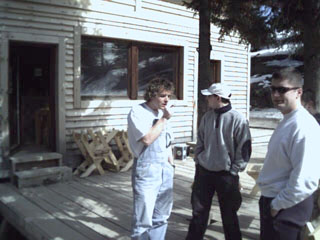 And he demonstrates well: he landed graciously every single trick he attempted over a small home-made kicker. As the dusk was closing in, we decided to pack up and go back to Luda Kuca, where the chef - an ex-cook from still closed American embassy in Belgrade - waited for us with about two pounds of beef, prepared in five different styles. I took Miljan to Sarajevo after dinner - he found a buyer for his snowboard, that he intended to sell at the end of the season - we drunk gallons of water to soak all that meat we ate.
And he demonstrates well: he landed graciously every single trick he attempted over a small home-made kicker. As the dusk was closing in, we decided to pack up and go back to Luda Kuca, where the chef - an ex-cook from still closed American embassy in Belgrade - waited for us with about two pounds of beef, prepared in five different styles. I took Miljan to Sarajevo after dinner - he found a buyer for his snowboard, that he intended to sell at the end of the season - we drunk gallons of water to soak all that meat we ate.
 Bosnian federation has one hundred riders (estimated), two snowboard instructors - certified in Slovenia, one snowboard-related shop in Sarajevo - named the X-treme shop, naturally - that sold a total of five decks this winter, and four feuding snowboard clubs - 3 in Sarajevo, 1 in Travnik: with no snow this season, they excell mostly in bad-mouthing each other. Snowboarders do become a cranky, short-tempered bunch if deprived from snow that long, this is a known effect, actually, and not at all endemic or characteristic only for Bosnia.
Bosnian federation has one hundred riders (estimated), two snowboard instructors - certified in Slovenia, one snowboard-related shop in Sarajevo - named the X-treme shop, naturally - that sold a total of five decks this winter, and four feuding snowboard clubs - 3 in Sarajevo, 1 in Travnik: with no snow this season, they excell mostly in bad-mouthing each other. Snowboarders do become a cranky, short-tempered bunch if deprived from snow that long, this is a known effect, actually, and not at all endemic or characteristic only for Bosnia.

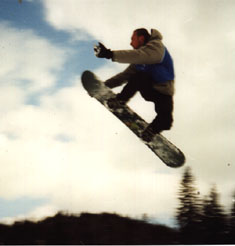 First, there is Sarajevo Student Snowboard Club, lead by Emir Haracic. Emir is a fine rider, riding Burton BMC, with five years experience, well honed free-style skills, perhaps, the most solid in Sarajevo, with a level I Slovenian instructor certification and a dry, war-survivor wit. He is also a consumate politician, securing FIS money for his club, sharing locker space with the Ski Association, renting Niedecker boards, having his own alter-rock radio show at the Radio 3. SSSC hosted last year’s Big Air and Boarder-Cross, for which Emir got Sprite sponsorship. The Boarder-Cross was won by a guy from Belgrade. There were three women participating, too: one reached the end line, all three got medals. The club consists of anyway between 5 and 30 people - depending on who is doing the talking.
First, there is Sarajevo Student Snowboard Club, lead by Emir Haracic. Emir is a fine rider, riding Burton BMC, with five years experience, well honed free-style skills, perhaps, the most solid in Sarajevo, with a level I Slovenian instructor certification and a dry, war-survivor wit. He is also a consumate politician, securing FIS money for his club, sharing locker space with the Ski Association, renting Niedecker boards, having his own alter-rock radio show at the Radio 3. SSSC hosted last year’s Big Air and Boarder-Cross, for which Emir got Sprite sponsorship. The Boarder-Cross was won by a guy from Belgrade. There were three women participating, too: one reached the end line, all three got medals. The club consists of anyway between 5 and 30 people - depending on who is doing the talking.
 Emir and Ismar Biogradlic - in this picture last year still smiling together - respect each other, but do not work together any more. Ismar now runs the aforementioned X-treme shop. His shop rents and sells Niedecker boards.
Emir and Ismar Biogradlic - in this picture last year still smiling together - respect each other, but do not work together any more. Ismar now runs the aforementioned X-treme shop. His shop rents and sells Niedecker boards.  Despite being strategically placed near the hard-core punk café Barhana, he makes money, in the dry Bosnian economy and in the dry Bosnian winter, mostly by selling over-priced ‘cool’ T-shirts to SFOR soldiers. As a curiosity I noted that Burton is not present in Bosnia and that the under the table third hand Niedecker boards rule the scene (Haracic got his board through the Burton rep in Serbia). Despite being strategically placed near the hard-core punk café Barhana, he makes money, in the dry Bosnian economy and in the dry Bosnian winter, mostly by selling over-priced ‘cool’ T-shirts to SFOR soldiers. As a curiosity I noted that Burton is not present in Bosnia and that the under the table third hand Niedecker boards rule the scene (Haracic got his board through the Burton rep in Serbia). 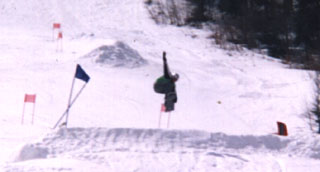 He has 3 years experience riding and he is also Level I certified instructor in Slovenia. Before he started snowboarding, he was on the Bosnian luge team, placing 23rd at the Olympics in Nagano 1998. His obvious asset in the Bosnian neo-patrimonial societal settings, is his personal friendship with Enes Terzic, the president of the Bosnian Luge Association, and the chief executive of the corporation that runs the Bjelasnica ski-resort. Ismar idealistically prefers ISF to FIS, which globally may be the position to take, yet it is highly impractical in Bosnia, where one can get money through FIS and not through ISF. He has 3 years experience riding and he is also Level I certified instructor in Slovenia. Before he started snowboarding, he was on the Bosnian luge team, placing 23rd at the Olympics in Nagano 1998. His obvious asset in the Bosnian neo-patrimonial societal settings, is his personal friendship with Enes Terzic, the president of the Bosnian Luge Association, and the chief executive of the corporation that runs the Bjelasnica ski-resort. Ismar idealistically prefers ISF to FIS, which globally may be the position to take, yet it is highly impractical in Bosnia, where one can get money through FIS and not through ISF. | 
|
 The third club in Sarajevo, the XS, is organized by Emir Masovic - yet another former close friend of Emir Haracic (he taught him how to ride), although Masovic does not enjoy Haracic’s respect the way Biogradlic does. XS got their paws on a house on Bjelasnica, though. With scarcity of lodging and other amenities on Bjelasnica, this is a premium prize, although it is not quite clear how many riders and of what ability does XS attract.
The third club in Sarajevo, the XS, is organized by Emir Masovic - yet another former close friend of Emir Haracic (he taught him how to ride), although Masovic does not enjoy Haracic’s respect the way Biogradlic does. XS got their paws on a house on Bjelasnica, though. With scarcity of lodging and other amenities on Bjelasnica, this is a premium prize, although it is not quite clear how many riders and of what ability does XS attract.
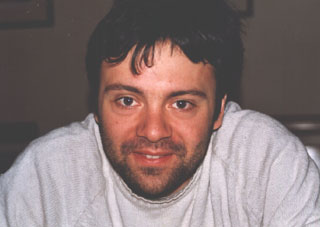 Croatia is a country with virtually no winter sports tradition. There is a total of 14 ski lifts spread over four or five little hills with no snow-making. Croatian ski and snowboard instructors get certified in Austria and Slovenia, and train there or - like this year - in France. Yet, Croatia this year has a woman World Cup champion and an Olympic gold medalist: Janica Kostelic. Although her father and coach displays generalized and unfunded hatred against snowboarders (some snowboarders broke into his place in Austria once), Croatia has among 1000 riders, 15 instructors, 2 snowboard clubs and 15 pro-level riders, two of whom, both Burton sponsored, compete for world rankings: Sanja Mladenovic (her dad runs one of Croatia’s miniature ski-resorts - Platak) and Sebastijan Fleiss, whose trade includes 900 corkscrew, superman and 540 mc-twist in pipe.
Croatia is a country with virtually no winter sports tradition. There is a total of 14 ski lifts spread over four or five little hills with no snow-making. Croatian ski and snowboard instructors get certified in Austria and Slovenia, and train there or - like this year - in France. Yet, Croatia this year has a woman World Cup champion and an Olympic gold medalist: Janica Kostelic. Although her father and coach displays generalized and unfunded hatred against snowboarders (some snowboarders broke into his place in Austria once), Croatia has among 1000 riders, 15 instructors, 2 snowboard clubs and 15 pro-level riders, two of whom, both Burton sponsored, compete for world rankings: Sanja Mladenovic (her dad runs one of Croatia’s miniature ski-resorts - Platak) and Sebastijan Fleiss, whose trade includes 900 corkscrew, superman and 540 mc-twist in pipe.  The development of snowboarding in Croatia is largely tied to the devotion of Tomislav Tiska, Burton rep since 1997, development team level instructor in Slovenia, riding since 1985, competed in early 1990s, founder of Burton LTR (Learn To Ride) Method school in Croatia - which is also, presently, the only night LTR in the world.
The development of snowboarding in Croatia is largely tied to the devotion of Tomislav Tiska, Burton rep since 1997, development team level instructor in Slovenia, riding since 1985, competed in early 1990s, founder of Burton LTR (Learn To Ride) Method school in Croatia - which is also, presently, the only night LTR in the world.
 Note:
Note:
Unlike Croatia, Bosnia and Serbia, Slovenia, the norther-most former Yugoslav republic, situated at the South-East end of the Alps, with the Vermont-like climate and attitude, is a home to some of the best European snowboarders. There is even a snowboard specific manufacturer GOLTES, that competes against the famous local ski manufacturer Elan (that now owned by a Croatian bank also makes snowboards in its factories in Austria). Here are some boarding sites in Slovenia:
The First Snowboard Peace Camp as of February 2004, would look like this:

 |  |  |